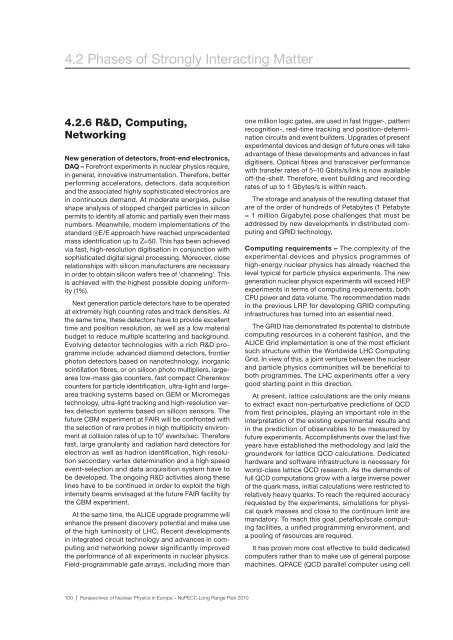Perspectives of Nuclear Physics in Europe - European Science ...
Perspectives of Nuclear Physics in Europe - European Science ...
Perspectives of Nuclear Physics in Europe - European Science ...
Create successful ePaper yourself
Turn your PDF publications into a flip-book with our unique Google optimized e-Paper software.
4.2 Phases <strong>of</strong> Strongly Interact<strong>in</strong>g Matter<br />
4.2.6 R&D, Comput<strong>in</strong>g,<br />
Network<strong>in</strong>g<br />
New generation <strong>of</strong> detectors, front-end electronics,<br />
DAQ – Forefront experiments <strong>in</strong> nuclear physics require,<br />
<strong>in</strong> general, <strong>in</strong>novative <strong>in</strong>strumentation. Therefore, better<br />
perform<strong>in</strong>g accelerators, detectors, data acquisition<br />
and the associated highly sophisticated electronics are<br />
<strong>in</strong> cont<strong>in</strong>uous demand. At moderate energies, pulse<br />
shape analysis <strong>of</strong> stopped charged particles <strong>in</strong> silicon<br />
permits to identify all atomic and partially even their mass<br />
numbers. Meanwhile, modern implementations <strong>of</strong> the<br />
standard ⊗E/E approach have reached unprecedented<br />
mass identification up to Z=50. This has been achieved<br />
via fast, high-resolution digitisation <strong>in</strong> conjunction with<br />
sophisticated digital signal process<strong>in</strong>g. Moreover, close<br />
relationships with silicon manufacturers are necessary<br />
<strong>in</strong> order to obta<strong>in</strong> silicon wafers free <strong>of</strong> ‘channel<strong>in</strong>g’. This<br />
is achieved with the highest possible dop<strong>in</strong>g uniformity<br />
(1%).<br />
Next generation particle detectors have to be operated<br />
at extremely high count<strong>in</strong>g rates and track densities. At<br />
the same time, these detectors have to provide excellent<br />
time and position resolution, as well as a low material<br />
budget to reduce multiple scatter<strong>in</strong>g and background.<br />
Evolv<strong>in</strong>g detector technologies with a rich R&D programme<br />
<strong>in</strong>clude: advanced diamond detectors, frontier<br />
photon detectors based on nanotechnology, <strong>in</strong>organic<br />
sc<strong>in</strong>tillation fibres, or on silicon photo multipliers, largearea<br />
low-mass gas counters, fast compact Cherenkov<br />
counters for particle identification, ultra-light and largearea<br />
track<strong>in</strong>g systems based on GEM or Micromegas<br />
technology, ultra-light track<strong>in</strong>g and high-resolution vertex<br />
detection systems based on silicon sensors. The<br />
future CBM experiment at FAIR will be confronted with<br />
the selection <strong>of</strong> rare probes <strong>in</strong> high multiplicity environment<br />
at collision rates <strong>of</strong> up to 10 7 events/sec. Therefore<br />
fast, large granularity and radiation hard detectors for<br />
electron as well as hadron identification, high resolution<br />
secondary vertex determ<strong>in</strong>ation and a high speed<br />
event-selection and data acquisition system have to<br />
be developed. The ongo<strong>in</strong>g R&D activities along these<br />
l<strong>in</strong>es have to be cont<strong>in</strong>ued <strong>in</strong> order to exploit the high<br />
<strong>in</strong>tensity beams envisaged at the future FAIR facility by<br />
the CBM experiment.<br />
At the same time, the ALICE upgrade programme will<br />
enhance the present discovery potential and make use<br />
<strong>of</strong> the high lum<strong>in</strong>osity <strong>of</strong> LHC. Recent developments<br />
<strong>in</strong> <strong>in</strong>tegrated circuit technology and advances <strong>in</strong> comput<strong>in</strong>g<br />
and network<strong>in</strong>g power significantly improved<br />
the performance <strong>of</strong> all experiments <strong>in</strong> nuclear physics.<br />
Field-programmable gate arrays, <strong>in</strong>clud<strong>in</strong>g more than<br />
one million logic gates, are used <strong>in</strong> fast trigger-, pattern<br />
recognition-, real-time track<strong>in</strong>g and position-determ<strong>in</strong>ation<br />
circuits and event builders. Upgrades <strong>of</strong> present<br />
experimental devices and design <strong>of</strong> future ones will take<br />
advantage <strong>of</strong> these developments and advances <strong>in</strong> fast<br />
digitisers. Optical fibres and transceiver performance<br />
with transfer rates <strong>of</strong> 5–10 Gbits/s/l<strong>in</strong>k is now available<br />
<strong>of</strong>f-the-shelf. Therefore, event build<strong>in</strong>g and record<strong>in</strong>g<br />
rates <strong>of</strong> up to 1 Gbytes/s is with<strong>in</strong> reach.<br />
The storage and analysis <strong>of</strong> the result<strong>in</strong>g dataset that<br />
are <strong>of</strong> the order <strong>of</strong> hundreds <strong>of</strong> Petabytes (1 Petabyte<br />
= 1 million Gigabyte) pose challenges that must be<br />
addressed by new developments <strong>in</strong> distributed comput<strong>in</strong>g<br />
and GRID technology.<br />
Comput<strong>in</strong>g requirements – The complexity <strong>of</strong> the<br />
experimental devices and physics programmes <strong>of</strong><br />
high-energy nuclear physics has already reached the<br />
level typical for particle physics experiments. The new<br />
generation nuclear physics experiments will exceed HEP<br />
experiments <strong>in</strong> terms <strong>of</strong> comput<strong>in</strong>g requirements, both<br />
CPU power and data volume. The recommendation made<br />
<strong>in</strong> the previous LRP for develop<strong>in</strong>g GRID comput<strong>in</strong>g<br />
<strong>in</strong>frastructures has turned <strong>in</strong>to an essential need.<br />
The GRID has demonstrated its potential to distribute<br />
comput<strong>in</strong>g resources <strong>in</strong> a coherent fashion, and the<br />
ALICE Grid implementation is one <strong>of</strong> the most efficient<br />
such structure with<strong>in</strong> the Worldwide LHC Comput<strong>in</strong>g<br />
Grid. In view <strong>of</strong> this, a jo<strong>in</strong>t venture between the nuclear<br />
and particle physics communities will be beneficial to<br />
both programmes. The LHC experiments <strong>of</strong>fer a very<br />
good start<strong>in</strong>g po<strong>in</strong>t <strong>in</strong> this direction.<br />
At present, lattice calculations are the only means<br />
to extract exact non-perturbative predictions <strong>of</strong> QCD<br />
from first pr<strong>in</strong>ciples, play<strong>in</strong>g an important role <strong>in</strong> the<br />
<strong>in</strong>terpretation <strong>of</strong> the exist<strong>in</strong>g experimental results and<br />
<strong>in</strong> the prediction <strong>of</strong> observables to be measured by<br />
future experiments. Accomplishments over the last five<br />
years have established the methodology and laid the<br />
groundwork for lattice QCD calculations. Dedicated<br />
hardware and s<strong>of</strong>tware <strong>in</strong>frastructure is necessary for<br />
world-class lattice QCD research. As the demands <strong>of</strong><br />
full QCD computations grow with a large <strong>in</strong>verse power<br />
<strong>of</strong> the quark mass, <strong>in</strong>itial calculations were restricted to<br />
relatively heavy quarks. To reach the required accuracy<br />
requested by the experiments, simulations for physical<br />
quark masses and close to the cont<strong>in</strong>uum limit are<br />
mandatory. To reach this goal, petaflop/scale comput<strong>in</strong>g<br />
facilities, a unified programm<strong>in</strong>g environment, and<br />
a pool<strong>in</strong>g <strong>of</strong> resources are required.<br />
It has proven more cost effective to build dedicated<br />
computers rather than to make use <strong>of</strong> general purpose<br />
mach<strong>in</strong>es. QPACE (QCD parallel computer us<strong>in</strong>g cell<br />
100 | <strong>Perspectives</strong> <strong>of</strong> <strong>Nuclear</strong> <strong>Physics</strong> <strong>in</strong> <strong>Europe</strong> – NuPECC Long Range Plan 2010
















